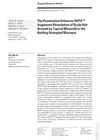The Treatment of Resistant Hypertension
January 1976
in “
Drugs
”
TLDR New treatments improved blood pressure control in patients with resistant hypertension.
In 1976, resistant hypertension, defined as a lack of blood pressure response to hypotensive agents, was a common issue. The study found that controlling standing blood pressure often improved target organ damage and papilloedema, but uncontrolled supine blood pressure could still lead to progression. The advent of thiazides and adrenergic blocking agents made blood pressure control more achievable. Combining hydrallazine or prazosin with a thiazide and β-adrenoreceptor blocking agent significantly reduced both lying and standing blood pressure. However, some patients remained resistant to maximum doses and required treatment with oral diazoxide or minoxidil, both powerful vasodilators. Oral diazoxide allowed a 10-fold reduction in the doses of other agents, while minoxidil needed to be combined with moderate doses of β-blocking agents. Two patients proved resistant to minoxidil but responded to oral diazoxide.
